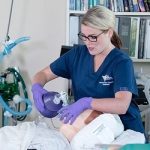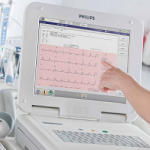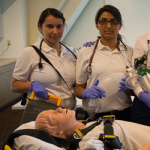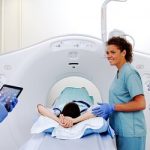What is a Medical Assistant?
As a Medical Assistant, you will work alongside medical staff such as doctors, nurses, and the office team to make sure that patients have all of the necessary care available.
There are many things that need to be done on a daily basis for a Medical Assistant, both clerical and in the medical exam room.
This helps to maintain an organized office and offers to bridge the gap between the doctors and the office team.
Working in this career means that you will have opportunities in various places, including hospitals, assisted living facilities, government-run health centers, and private practices.
Duties
Since every patient is diverse and has different needs, a Medical Assistant will perform several important tasks throughout their workday.
Some of the things that you can expect to do as a Medical Assistant include:
- Scheduling appointments
- Answering patient questions
- Filling out patient paperwork
- Maintaining appropriate records
- Taking patient vital signs
- Getting a patient ready to see the doctor
Salary
The average salary in the United States for a Medical Assistant is $37,190 a year.
Medical Assistants who do not have much education or experience will make a bit less, at around $29,070 to begin with.
After years of hands-on experience and certifications, the most you can make as a Medical Assistant is $48,170 in some areas.
States like California and Massachusetts pay their Medical Assistants over $40,000 a year.
While in less populated states, like Ohio or Kentucky, the Medical Assistants make closer to $35,000 a year.
Working in large hospitals or medical facilities will also provide higher salaries than working in private offices or clinics.
Annually National Average Salary: $44,720
Average Annual Salary by State
| State | Avg. Annual Salary |
|---|---|
| Alabama | $34,860 |
| Alaska | $57,630 |
| Arizona | $45,010 |
| Arkansas | $38,060 |
| California | $52,770 |
| Connecticut | $47,280 |
| Delaware | $42,500 |
| District of Columbia | $52,880 |
| Florida | $42,970 |
| Georgia | $40,890 |
| Hawaii | $50,030 |
| Idaho | $43,600 |
| Illinois | $44,870 |
| Indiana | $42,490 |
| Iowa | $43,500 |
| Kansas | $40,700 |
| Kentucky | $39,420 |
| Louisiana | $34,900 |
| Maine | $46,940 |
| Maryland | $45,260 |
| Massachusetts | $50,390 |
| Michigan | $40,600 |
| Minnesota | $50,190 |
| Mississippi | $35,620 |
| Missouri | $40,500 |
| Montana | $45,060 |
| Nebraska | $45,090 |
| Nevada | $42,740 |
| New Hampshire | $47,770 |
| New Jersey | $46,000 |
| New Mexico | $40,760 |
| New York | $48,050 |
| North Carolina | $42,520 |
| North Dakota | $43,450 |
| Ohio | $41,830 |
| Oklahoma | $38,650 |
| Oregon | $51,120 |
| Pennsylvania | $42,940 |
| Rhode Island | $45,670 |
| South Carolina | $40,070 |
| South Dakota | $40,190 |
| Tennessee | $40,070 |
| Texas | $40,470 |
| Utah | $42,710 |
| Vermont | $45,610 |
| Virginia | $42,260 |
| Washington | $55,050 |
| West Virginia | $35,990 |
| Wisconsin | $47,230 |
| Wyoming | $40,830 |
| Guam | $31,430 |
| Puerto Rico | $30,270 |
| Virgin Islands | $38,460 |
Annual Average Salary: Top 5 States
The top earning state in the field is Alaska, where the average salary is $57,630.
These are the top 5 earning states in the field:
* Employment conditions in your area may vary.
How to Become a Medical Assistant
Step 1 Enter a Program
Medical Assistants must have some knowledge about the medical field before entering the workforce.
This is why there are many programs available for those interested in this position.
To ensure you get the most out of your education, make sure that the program you enroll in is accredited by the Commission on Accreditation of Allied Health Education Programs.
Medical Assistant programs can last up to one year and may include an internship or externship.
For those expecting to grow in the medical field, an Associate’s degree can work better.
This degree can take around two years to finish and explores the career more in-depth.
Some of the classes that you will take as a medical Assistant in an Associates degree program include:
- Anatomy and Physiology
- Medical Terminology
- Billing and Coding
- Insurance
- Patient Care
- Phlebotomy
Step 2 Become Certified
It’s not a legal requirement to become certified in any state in the United States.
That doesn’t mean that employers don’t require some type of credential.
Oftentimes, working in a hospital or doctor’s office, you will need to show your competency in the field.
There are many types of certifications offered to Medical Assistants.
Make sure that the certification you apply for is accredited through the National Commission for Certifying Agencies.
Some of the certifications that you can expect as a Medical Assistant include:
- Certified Medical Assistant from the American Association of Medical Assistants
- Registered Medical Assistant from American Medical Technologists
- Certified Medical Administrative Assistant from the National Health Career Association
- Certified Clinical Medical Assistant from the National Health Career Association
In most cases involving certification, you will need to take an exam and pass before becoming certified.
Step 3 Gain Experience
Hands-on knowledge is key to this career, anyone will tell you that.
Once you graduate from a program, you should seek employment either through the internship that was done through your schooling, or many other places.
Areas that Medical Assistants can find careers are:
- Hospitals
- Clinics
- Doctors’ offices
- Urgent care
A Medical Assistant is necessary for almost all medical facilities, some of the types of duties that you can expect include:
- Office work
- Patient care
- Treatment and immunizations
There may also be opportunities to volunteer in your community.
While this may not pay, it will give you the experience needed to forge your way forward in this career.
After at least two years of experience working as a Medical Assistant, the opportunities will open up even more.
Step 4 Further Your Career
Some people consider working as a Medical Assistant to be an entry-level career, introducing you to the medical field.
If you feel this way too, you may want to think about working toward promotions or gaining certifications in order to get more traction at your job.
Those who have earned an Associate’s degree can think about going back to school to earn a Bachelor’s degree.
Earning a Bachelor’s degree in nursing or administration can open many more doors in the healthcare industry.
For those who are not interested in going back to school, certifications are available and abundant.
Some of the areas in which you can become certified include:
- Phlebotomy
- Administration
- Medications
Popular Programs
Education
While it is important to have some form of education as a Medical Assistant, the type of program you enroll in is completely up to you.
There are various styles of programs for Medical Assistants, some are online and can take about one year to finish.
Others are in person and can take anywhere from one year to 18 months to complete.
When looking for a Medical Assistant program, it’s crucial to make sure that it is accredited by the Commission on Accreditation of Allie Health Education Programs.
In a typical one-year Medical Assistant program, you will learn basic tasks in the medical field as well as administration.
The types of courses you should expect include:
- Phlebotomy
- Anatomy and Physiology
- Office Administration
- Patient Care
After graduating from a one-year program, you should expect to take on an entry-level position in the medical field.
Another option for aspiring Medical Assistants is to earn an Associate’s degree.
Often times, this takes about two years to finish, and many Medical Assistant programs are available at local community colleges and universities.
Both the one-year certificate programs and the Associate’s degree programs will offer internships or externships so that students can gain hands-on knowledge.
With an Associate’s degree, you will delve deeper into the career of Medical Assisting.
The classes that are available in this style of the program are:
- Medical Insurance
- Pharmacology
- Bookkeeping
- Medical Law and Ethics
- Endocrinology
- Laboratory Procedures
With an Associate’s degree, the career opportunities open up a little more.
However, if you plan to work your way up in the medical field, a Bachelor’s degree may be the right idea.
There isn’t a Medical Assistant Bachelors degree, but there are degrees to gain an education in the medical field, such as:
- Healthcare Management
- Health Sciences
- Nursing
With a Bachelor’s degree, the promotion and career opportunities get even bigger.
This type of degree can take another 2-4 years, depending on if any of the Associate’s degree credits transfer.
Video About The Career
Certification
Even though you don’t legally need to become licensed and certified as a Medical Assistant in the United States, many employers still require at least some type of credential before they will hire you.
This is to show that you are competent in the field and that you have hands-on experience to handle the pressures of the career.
With a career as a Medical Assistant, you will be able to find certifications that include:
- Certified Medical Assistant from the American Association of Medical Assistants
With this certification, you will need to have graduated from an accredited program in the last thirty days.
The cost to take the Certified Medical Assistant exam is $125.
There are many topics to study for this exam including:
- Psychology
- Communication
- Patient Navigation
- Medical Law
- Professionalism
- Medical Terminology
- Diagnostics
- Pharmacology
The exam is around 200 questions and can be done on the computer and in person at local testing centers across the country.
- Certified Clinical Medical Assistant from the National Health Career Association
In order to gain this certification, you will need to have completed a Medical Assistant education program within the last five years.
The exam costs around $150 to $200, depending on if you are a member of the National Health Career Association.
Along with taking this exam online, you can also find test areas across the United States.
You can expect to find these types of subjects on the exam:
- Microbiology
- General Patient Care
- Testing and Lab Procedures
- Medical Law and Ethics
- Psychology
- Pharmacology
Another popular certification is the Registered Medical Assistant given through the American Medical Technologists.
This certification requires that you have at least 720 education hours as a Medical Assistant before you can apply.
Once you have the required education, you can apply for the exam to become a Registered Medical Assistant.
It costs around $120 to take this exam, which consists of around 150 multiple-choice
questions.
You should expect the same types of subjects on this exam, as well as:
- Administrative Medical Assisting
- Clinical Medical Assisting
- Financial Bookkeeping
All of these certifications allow for retesting a few times a year in order to pass the exam.
Once you pass, you will become certified as a Medical Assistant and will need to recertify every 2-3 years, depending on the certification.
Average Training Program Duration: 1-2 Years
It shouldn’t take too long to become a Medical Assistant.
In fact, most Medical Assistants don’t require any type of certification program in order to gain certification.
All it takes is a degree and to pay the exam fee, and you will be able to take the necessary certification exam.
It is not legally required to have certification, but it does help with getting hired and maintaining knowledge of the career.
Those who want to take a certification program can expect it to last around 4-8 weeks.
Job Outlook
Building a career as a Medical Assistant will be easier to do over the next ten years and beyond.
This is because the job opportunities in this field will grow by around 18 percent throughout the coming decade.
This career will grow faster than many other careers in the medical field, and there are a few reasons for this.
First, the baby boomer population is aging out of the working years and starting to retire, opening up more career spots for new Medical Assistants.
Also, this aging generation will need more medical care in the coming years, which will allow for more positions as well.
This could be a great step into the medical field for some people, and others can be a Medical Assistant for their entire career.
Employment Growth Projection: 15%
2023
2033
That's a higher than average projected growth of 118,000
Should You Become a Medical Assistant?
Overall Satisfaction: High

Overall, the career of a Medical Assistant is ranked number two of the best careers that don’t require a degree.
However, without gaining a degree, there is very little upward mobility.
It’s also hard to find a job with flexibility with work schedules.
However, after earning a degree, such as an Associate’s degree, it’s possible to gain promotions and raises in this career.
This career also has a high-stress level, due to its being part of the medical field.
Average Salary: Medium

Since there is little education needed to work as a Medical Assistant, the salary can be a bit low in some areas.
A Medical Assistant with no experience and education can expect to make around $29,070 a year.
The average Medical Assistant will make $37,190 a year in the United States.
With more education and certifications, it’s possible to make up to $48,170 as a Medical Assistant.
Depending on the type of facility you work in and the number of years you’ve worked as a Medical Assistant, your salary can change.
Job Growth Outlook: High

This career will likely grow around 18 percent over the next ten years.
This means that there will be more opportunities available for employment, especially in hospitals, outpatient centers, and doctor’s offices.
Advancements in technology have made it easier to perform medical treatments, and the baby boomer population aging also contributes to this growth.
With this generation becoming elderly, they will require more medical care.
If you are looking for a career in the medical field, becoming a Medical Assistant is a great place to start.
Education Duration: 1-2 Years

There are different ways that you can become a Medical Assistant.
Some people earn a diploma or certificate from a Medical Assistant program, and others earn an Associate’s degree from a community college or university.
A Medical Assistant program can take about one year to complete and can often be found through hospitals or other medical facilities.
If you are looking to become a more senior role in the medical field, then it may be wise to earn an Associate degree.
The average Associate degree at a community college or university will take about two years to finish.
This means it can take anywhere from one year to two years to become a Medical Assistant.
Personal Skills Needed

It takes a bit of education to become a Medical Assistant, but it also takes a compassionate and caring person to succeed in this career.
Other skills that can have a role in how well you do in this job are:
- Communication skills
- Basic knowledge of medical terminology
- Office skills
- Understanding of diversity
- Self-control
- Ability to stay calm under pressure
- Reliability
- Honesty
- Organizational skills
- Ability to work as a team and alone
- Adaptability
- Quick on your toes
- Physical stamina
- Integrity
Frequently Asked Questions
How much does a Medical Assistant make?
The average Medical Assistant makes about $37,190 a year.
However, when just starting this career, you should expect a salary closer to $29,070, especially if you don’t have any experience.
After working a couple of years and gaining certifications, it’s possible to make up to $48,170 as a Medical Assistant.
This career has many paths that can lead to promotions and raises along the way.
How long does it take to become a Medical Assistant?
There isn’t a specific type of program or degree you must obtain in order to work as a Medical Assistant.
However, most Medical Assistants attend a one-year program or earn an Associate’s degree.
There are Medical Assistant programs that can take as little as 7 months but may not offer much education.
An Associate’s degree can take around 2 years to finish.
The amount of time it can take you to become a Medical Assistant is anywhere from 7 months to 2 years.
What does a Medical Assistant do?
There are many tasks that a Medical Assistant must perform in a day.
Not only do Medical Assistants do clerical work, but they also check in patients and take vitals.
Moving between the office and the patient care room, a Medical Assistant has many roles.
Expect to work closely with patients and doctors in this career, as well as have a knack for math and science.
What is the demand for Medical Assistants?
Medical Assistants are in high demand, and will likely continue to be for many years to come.
This career is expected to grow nearly 18 percent over the next decade.
That is a lot more than many other careers in the medical field.
The reason for this growth is that Medical Assistants are taking on new responsibilities within the medical facility they work in, and they can do so with little education.
How much does it cost to become a Medical Assistant?
Based on the type of program you enroll in, the amount you will pay to become a Medical Assistant can vary.
A one year program can cost anywhere from $1,500 to $3,000.
While an Associate’s degree can range from $10,000 to $15,000, depending on the school or university you attend.
The average Bachelor’s degree can run anywhere from $25,000 to $35,000.
 Medical Assistant Info by State
Medical Assistant Info by State

- Alabama
- Alaska
- Arizona
- Arkansas
- California
- Colorado
- Connecticut
- Delaware
- Florida
- Georgia
- Hawaii
- Idaho
- Illinois
- Indiana
- Iowa
- Kansas
- Kentucky
- Louisiana
- Maine
- Maryland
- Massachusetts
- Michigan
- Minnesota
- Mississippi
- Missouri
- Montana
- Nebraska
- Nevada
- New Hampshire
- New Jersey
- New Mexico
- New York
- North Carolina
- North Dakota
- Ohio
- Oklahoma
- Oregon
- Pennsylvania
- Rhode Island
- South Carolina
- South Dakota
- Tennessee
- Texas
- Utah
- Vermont
- Virginia
- Washington
- West Virginia
- Wisconsin
- Wyoming
Medical Assistant Resources
- 14 Pros and Cons of Being a Medical Assistant
- Can I Work as an MA without Certification
- Clinical Medical Assistant Specialized Job Skills
- Differences Between CNA and Medical Assistants
- Finding a Medical Assisting Job With No Experience
- Four Types of Medical Assistant Careers
- How Much Does Medical Assistant School Cost?
- How to Advance in Medical Assistant Career Field
- Medical Assistant Certification
- Medical Assistant Duties and Responsibilities
- Medical Assistant Job Description and Requirements
- Medical Assistant Trade Schools
- Medical Assisting Requirements
- Online Medical Assistant Training Programs
- Patient Care Technician Career Specialty
- Tips for Choosing a Medical Assisting Externship
- Tips To Pass the AAMA Test
- What Are CPT Codes And Why Do They Matter
- What Is a Clinical Medical Assistant
- What is a Medical Assistant
- What Is Included in a Typical Medical Assisting Course
- What Is The Difference Between A Medical Assistant And A Nurse
More Medical Careers
| Career | |
|---|---|
 | Certified Nursing Assistant Working as a Certified Nursing Assistant is an entry-level role that will give you hands-on experience when you are ready to take the next step in your medical career. |
 | Dental Assistant Dental assistants help dentists to provide patient care, keep records, and care for the dental equipment. |
 | Dental Hygienist Dental hygienists take care of cleaning teeth to promote hygiene and help avoid cavities and gum problems. |
 | Dialysis Technician Dialysis technicians maintain and monitor dialysis equipment, and also act as primary caregivers for patients undergoing dialysis treatment. |
 | Dog Groomer Dog groomers attend to grooming dogs, usually at dog salons or big pet-related chain stores. |
 | Healthcare Administrator Healthcare administrators – also known as healthcare executives or health services managers – are responsible for the planning, direction, and coordination of medical and health services. |
 | Home Health Aide Home health aides provide home care to individuals who require assistance in their day-to-day living. |
 | Licensed Practical Nurse (LPN) Licensed Practical Nurses provide basic nursing care to patients and work with Registered Nurses and Doctors. |
 | Medical Biller and Coder Medical billers and coders manage, organize, and code various health information data. |
 | Medical Technologist Medical laboratory technologists collect bodily samples and conduct tests to analyze those samples. |
 | Medical Transcriptionist Medical transcriptionists go over voice recordings to convert them into written texts. |
 | Nutritionist As a Nutritionist, you’ll be tasked with creating meal plans, counseling, and understanding dietary restrictions for all types of clients. |
 | Patient Access Representative The work involves helping people to orient themselves to the space and everything that is going on. |
 | Patient Care Technician Patient care techs work directly with patients helping them with daily activities and assist the medical staff by measuring and monitoring the patients' vital signs among other tasks. |
 | Pharmacy Technician Pharmacy technicians provide patients with medications through prescription or over the counter. |
 | Phlebotomist As a Phlebotomist, it will be your responsibility to take blood samples from patients and send them to the lab for further testing. |
 | Physical Therapist Assistant Physical therapist assistants provide physical therapy services to patients and aide to physical therapists. |
 | Professional Recovery Coach A professional recovery coach is a life coach who works with someone during their addiction recovery process. |
 | Radiation Therapist Allied health provisional who specializes in radiation oncology treatments. |
 | Registered Health Information Technician Registered Health Information Technician (RHIT) help store and verify accuracy of health records as well as analyze patient data. |
 | Registered Nurse (RN) Registered Nurses provide hands-on patient care in various settings, mainly hospitals, and clinics. |
 | Respiratory Therapist Respiratory therapists treat and care for patients who experience breathing difficulties. |
 | Sterile Processing Technician A sterile processing technician is a healthcare professional who is responsible for preparing, sterilizing, maintaining, packaging, and storing medical tools and equipment used in surgical and other medical procedures. |
 | Surgical Technologist Surgical technologists – also known as operating room techs – prepare operating rooms and assist doctors and nurses during surgical procedures. |
 | Vet Office Manager Veterinary office managers work to make sure that the daily operations run smoothly and efficiently at veterinary hospitals or veterinary clinics. |
 | Veterinary Assistant Veterinary Assistants work closely with Veterinarians to handle routine animal care. |
 | Veterinary Technician Veterinary Technicians assist veterinarians as well as diagnosing and treating animals, mostly in private clinics. |
 | EKG Technician EKG technicians test and monitor the cardiovascular system. |
 | EMT Trained emergency medical technician that arrives at the scene to provide medical services such as resuscitation. |
 | MRI Technologist MRI Technologists use a machine to scan the body and create a detailed image of the inside for doctors to analyze. |
 | Optician Opticians are technicians and salespersons at the same time who spends most of their day talking to customers, reading prescriptions written by doctors, and dispensing glasses and lenses. |
 | Ultrasound Technician Ultrasound technicians aid physicians in monitoring and diagnosing patients through the use of ultrasonic imaging technology. |
 | X-Ray Technician X-Ray Technicians are medical imaging professionals who use technology to visualize the inside of our bodies. |














